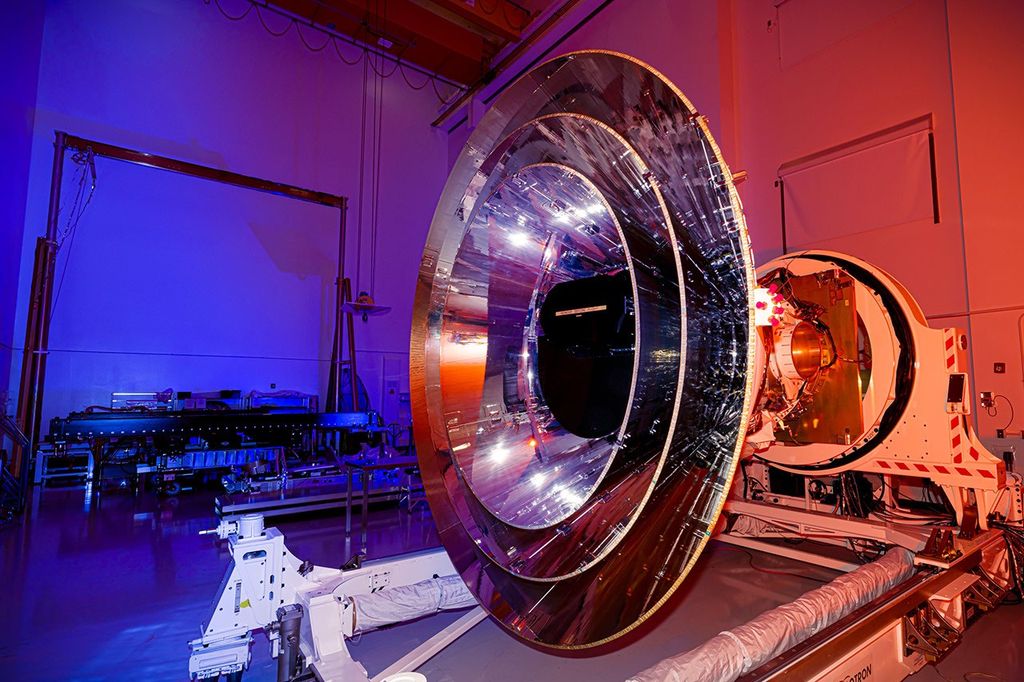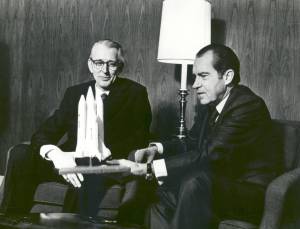In 1981, the Reagan administration issued a National Security Decision Directive (NSDD-8, November 13, 1981) that reiterated the central role of the Space Transportation System in U.S. space activities. The White House then initiated a comprehensive space policy review under the direction of new Science Adviser George Keyworth II. The results of that review were contained in NSDD-42, issued on July 4, 1982. This directive replaced NSDD-8 and the three Carter administration space policy statements, NSDD-37, 42, and 54. It also established as the primary forum for space policy formulation the National Security Council Senior Interagency Group (Space)—SIG (Space)—chaired by the Assistant to the President for National Security Affairs. SIG (Space) was the locus of policymaking throughout the two terms that Ronald Reagan was President. Available in NASA Historical Reference Collection, History Office, NASA Headquarters, Washington, DC. Page references to original document in brackets.
[1]
National Security Decision Directive Number 42
NATIONAL SPACE POLICY
July 4, 1982
I. Introduction and Principles
This directive establishes national policy to guide the conduct of United States space program and related activities; it supersedes Presidential Directives 37, 42, and 54, as well as National Security Decision Directive 8. This directive is consistent with and augments the guidance contained in existing directives, executive orders, and law. The decisions outlined in this directive provide the broad framework and the basis for the commitments necessary for the conduct of United States space programs.
The Space Shuttle is to be a major factor in the future evolution of United States space programs. It will continue to foster cooperation between the national security and civil efforts to ensure efficient and effective use of national resources. Specifically, routine use of the manned Space Shuttle will provide the opportunity to understand better and evaluate the role of man in space, to increase the utility of space programs, and to expand knowledge of the space environment.
The basic goals of United States space policy are to: (a) strengthen the security of the United States; (b) maintain United States space leadership; (c) obtain economic and scientific benefits through the exploitation of space; (d) expand United States private-sector investment and involvement in civil space and space-related activities; (e) promote international cooperative activities that are in the national interest; and (f) cooperate with other nations in maintaining the freedom of space for all activities that enhance the security and welfare of mankind.
[2] The United States space program shall be conducted in accordance with the following basic principles:
- A. The United States is committed to the exploration and use of outer space by all nations for peaceful purposes and for the benefit of all mankind. [Sentence deleted during declassification review]
- B. The United States rejects any claims to sovereignty by any nation over outer space or celestial bodies, or any portion thereof, and rejects any limitations on the fundamental right to acquire data from space.
- C. The United States considers the space systems of any nation to be national property with the right of passage through the operations in space without interference. Purposeful interference with space systems shall be viewed as infringement upon sovereign rights.
- D. The United States encourages domestic commercial exploration of space capabilities, technology, and systems for national economic benefit. These activities must be consistent with national security concerns, treaties, and international agreements.
- E. The United States will conduct international cooperative space-related activities that achieve sufficient scientific, political, economic, or national security benefits for the nation.
- F. [Paragraph deleted in declassification review]
- G. The United States Space Transportation System (STS) is the primary space launch system for both national security and civil government missions. STS capabilities and capacities shall be developed to meet appropriate national needs and shall be available to authorized users—domestic and foreign, commercial, and governmental. [3]
- H. The United States will pursue activities in space in support of its right of self-defense.
- I. The United States will continue to study space arms control options. The United States will consider verifiable and equitable arms control measures that would ban or otherwise limit testing and deployment of specific weapons systems should those measures be compatible with United States national security. The United States will oppose arms control concepts or legal regimes that seek general prohibitions on the military or intelligence use of space.
II. Space Transportation System
The Space Transportation System (STS) is composed of the Space shuttle, associated upper stages, and related facilities. The following policies shall govern the development and operation of the STS:
- A. The STS is a vital element of the United States space program and is the primary space launch system for both United States national security and civil government missions. The STS will be afforded the degree of survivability and security protection required for a critical national space resource.
- B. The first priority of the STS program is to make the system fully operational and cost-effective in providing routine access to space.
- C. The United States is fully committed to maintaining world leadership in space transportation with an STS capacity sufficient to meet appropriate national needs. The STS program requires sustained commitments by all affected departments and agencies. The United States will continue to develop the STS through the National Aeronautics and Space Administration (NASA) in cooperation with the Department of Defense (DoD). Enhancements of STS operational capability, upper stages, and efficient methods of deploying and retrieving payloads should be pursued as national requirements are defined.
- D. United States Government spacecraft should be designed to take advantage of the unique capabilities of the STS. The completion of transition to the Shuttle should occur as expeditiously as practical. [4]
- E. [Paragraph deleted in declassification review]
- F. Expandable launch vehicle operations shall be continued by the United States Government until the capabilities of the STS are sufficient to meet its needs and obligations. Unique national security considerations may dictate developing special-purpose launch capabilities.
- G. For the near-term, the STS will continue to be managed and operated in an institutional arrangement consistent with the current NASA/DoD Memoranda of Understanding. Responsibility will remain in NASA for operational control of the STS for civil missions and in the DoD for operational control of the STS for national security missions. Mission management is the responsibility of the mission agency. As the STS operations mature, options will be considered for possible transition to a different institutional structure.
- H. Major changes to STS program capabilities will require Presidential approval.
III. Civil Space Program
The United States shall conduct civil space programs to expand knowledge of the Earth, its environment, the solar system, and the universe; to develop and promote selected civil applications of space technology; to preserve the United States leadership in critical aspects of space science, applications, and technology; and to further United States domestic and foreign policy objectives. Consistent with the National Aeronautics and Space Act, the following policies shall govern the conduct of the civil space program.
- A. Science, Applications, and Technology: United States Government civil programs shall continue a balanced strategy of research, development, operations, and exploration for science, applications, and technology. The key objectives of these programs are to:
- (1) Preserve the United States preeminence in critical major space activities to enable continued exploitation and exploration of space. [5]
- (2) Conduct research and experimentation to expand understanding of: (a) astrophysical phenomena and the origin and evolution of the universe, through long-term astrophysical observation; (b) the Earth, its environment, and its dynamic relation with the Sun; (c) the origin and evolution of the solar system, through solar, planetary, and lunar sciences and exploration; and (d) the space environment and technology required to advance knowledge in the biological sciences.
- (3) Continue to explore the requirements, operational concepts, and technology associated with permanent space facilities.
- (4) Conduct appropriate research and experimentation in advanced technology and systems to provide a basis for future civil space applications.
- B. Private Sector Participation: The United States Government will provide a climate conducive to expanded private sector investment and involvement in civil space activities, with due regard to public safety and national security. Private sector space activities will be authorized and supervised or regulated by the government to the extent required by treaty and national security.
- C. International Cooperation: United States cooperation in international civil activities will:
- (1) Support the public, nondiscriminatory direct readout of data from Federal civil systems to foreign ground stations and provision of data to foreign users under specified conditions.
- (2) Continue cooperation with other nations by conducting joint scientific and research programs that yield sufficient benefits to the United States in areas such as access to foreign scientific and technological expertise, and access to foreign research and development facilities, and that serve other national goals. All international space ventures must be consistent with United States technology-transfer policy.
- D. Civil Operational Remote Sensing: Management of Federal civil operational remote sensing is the responsibility of the Department of Commerce. The Department of Commerce will: (a) aggregate Federal needs for civil operational remote sensing to be met by either the private sector or the Federal government; (b) identify needed civil operational system research and development objectives; and (c) in coordination with other departments or agencies, provide for regulation of private-sector operational remote sensing systems.
[6] [Page deleted in declassification review]
[7] [Page deleted in declassification review]
[8] [Paragraph deleted in declassification review]
- (1) The fact that the United States conducts satellite photoreconnaissance for peaceful purposes, including intelligence collection and the monitoring of arms control agreements, is unclassified. The fact that such photoreconnaissance includes a near-real-time capability and is used to provide defense related information for indications and warning is also unclassified. All other details, facts and products concerning the national foreign intelligence space program are subject to appropriate classification and security controls.
- (2) [Paragraph deleted in declassification review]
VI. Inter-Sector Responsibilities
[Paragraphs A–F deleted in declassification review]
[9]
- G. The United States Government will maintain and coordinate separate national security and civil operational space systems when differing needs of the sectors dictate.
VII. Implementation
Normal interagency coordinating mechanisms will be employed to the maximum extent possible to implement the policies enunciated in this directive. To provide a forum to all Federal agencies for their policy views, to review and advise on proposed changes to national space policy, and to provide for orderly and rapid referral of space policy issues to the President for decisions as necessary, a Senior Interagency Group (SIG) on Space shall be established. The SIG (Space) will be chaired by the Assistant to the President for National Security Affairs and will include the Deputy or Under Secretary of State, Deputy or Under Secretary of Defense, Deputy or Under Secretary of Commerce, Director of Central Intelligence, Chairman of the Joint Chiefs of Staff, Director of the Arms Control and Disarmament Agency, and the [10] Administrator of the National Aeronautics and Space Administration. Representatives of the Office of Management and Budget and the Office of Science and Technology Policy will be include as observers. Other agencies or departments will participate based on the subjects to be addressed.































